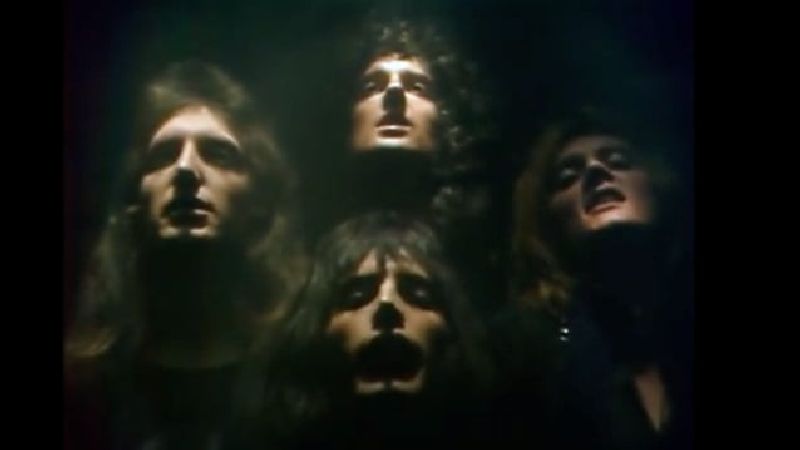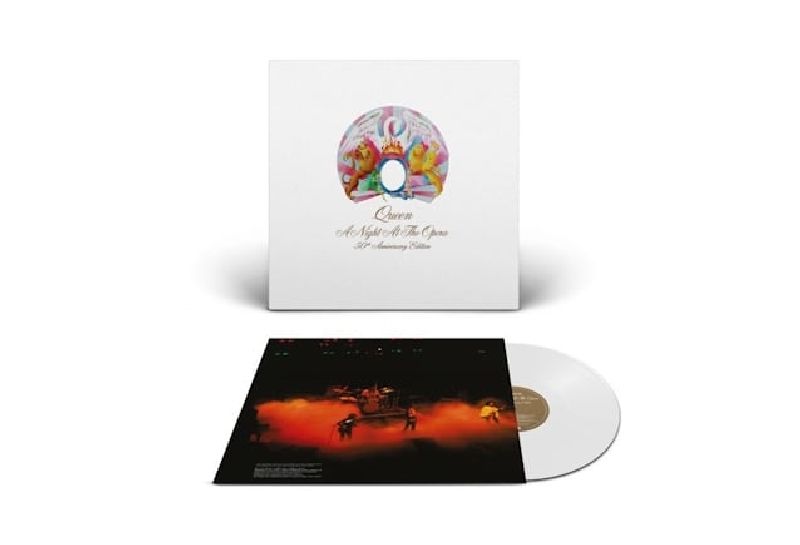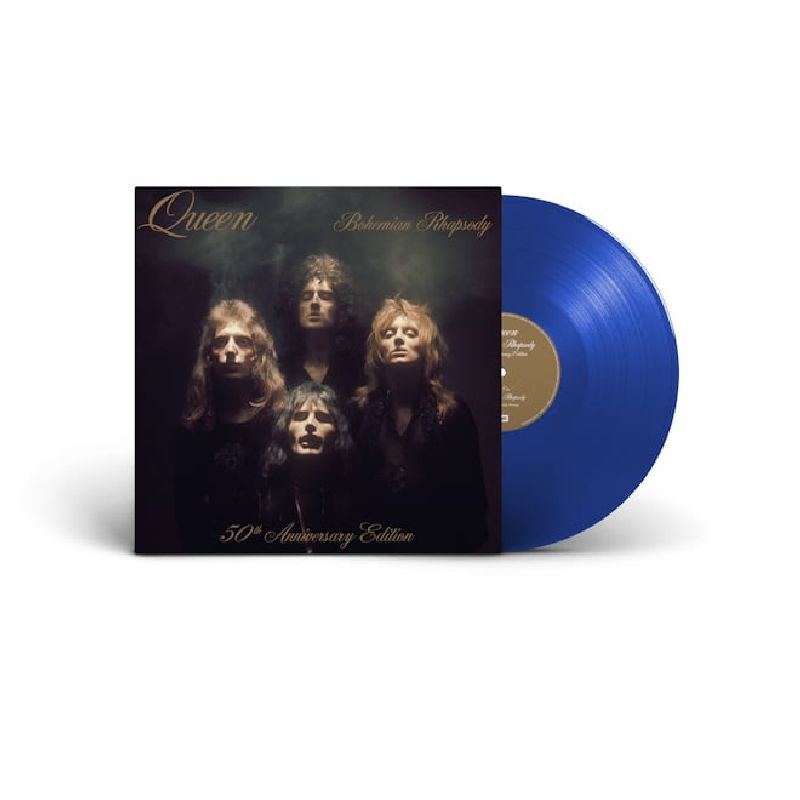QUEEN: new 'The Greatest' series celebrates 50th anniversary of 'Bohemian Rhapsody'

03-11-2025
On October 31, 1975, QUEEN‘s masterpiece “Bohemian Rhapsody” was released and began the journey to becoming one of the greatest songs of all time. Brilliant and completely unique, its creative and technical complexity sent shockwaves throughout the music industry, taking everyone by surprise. Everyone, that is, except the band, who by this point had become well used to QUEEN singer Freddie Mercury‘s extraordinary flights of fantasy. In exclusive interviews for “Queen The Greatest”, QUEEN guitarist Brian May and drummer Roger Taylor highlight the songs that paved the road to “Bohemian Rhapsody”.
While to the outside world “Bohemian Rhapsody” is regarded as QUEEN‘s masterstroke, for May and Taylor, talking in this first episode of a new series of “Queen The Greatest”, this was very much a typical day’s work with Freddie.
“You didn’t know where Freddie was coming from,” says Brian. “He comes in and goes ‘there’s this bit, and there’s another bit we’ll do, and there’s the operatic and then there’s another bit we will do.’ ‘Oh, yeah, okay, Freddie.’ And basically, you have two choices, either going ‘well we’re really not feeling it,’ which we sometimes would do, or we all dive in, and the whole QUEEN machine swings into action.”
Clearly for Freddie, Brian, Roger and QUEEN bassist John Deacon, “Bohemian Rhapsody” was part of the natural evolution of QUEEN, and in these interviews Brian and Roger explain where from a songwriting point of view this evolution began.
May points to the band’s first album, QUEEN and its track “My Fairy King”: “Piano based, quite complex, lots of mood changes and a fantasy lyric.”
Taylor concurs: “I think it was certainly part of Freddie‘s journey. Obviously when we did ‘Bohemian Rhapsody’ we didn’t know we were going to end up with that. Part of our thing was really experimentation, and it’s very much on our first album, the track ‘My Fairy King’, which I think is one of the more interesting tracks, it was complicated, had a lot of difficult vocals, and it had fantastic elements.”
Taylor continues: “On the second album, ‘Queen II’, there’s a monumentally long and complicated track, ‘March Of The Black Queen’, which involved a lot of rehearsal, a lot of singing and so many different little sections. It’s a lot more complicated in many ways than ‘Bohemian Rhapsody’. It had all the different ingredients ‘Bohemian Rhapsody’ had. It’s a track I like to listen to because of the complexity of it. I can’t believe we learned it all; it was so bloody long and laborious but satisfying.”
May points to a further example of Freddie‘s evolution as a songwriter: “Now ‘The Fairy Feller’s Masterstroke’ is incredibly complex, and ought to be just as shocking to people as ‘Bohemian Rhapsody’, because it’s unique. No one’s ever done anything like that, and all these little pieces that come in and go out and tings and contrapuntal things, and he’s doing something over here, I’m doing something over here. We just remixed it all, and it’s fascinating to make it all work.”
Taylor agrees: “It’s incredibly complicated. There are swooping, counter six-part harmonies here, there, coming in and crossing. It’s very bloody complicated that song — and rather wonderful in its eccentricity, I think. Yeah. It’s a nice, interesting track. It didn’t come across as big as we thought it would, but it’s an interesting exercise in eccentric over-elaboration.”
“But this is Freddie and this is QUEEN,” adds May, “because this is the kind of music we’re evolving as we go along quite gradually.”
While neither “March Of The Black Queen” or “The Fairy Feller’s Masterstroke” enjoys the same profile as “Bohemian Rhapsody”, they undoubtably laid the path to QUEEN‘s most famous song.
The new series of “Queen The Greatest” will continue weekly throughout November.
“Bohemian Rhapsody” was released on heavyweight blue 7″ and 12″ single, 12″ picture disc and blue cassette single on October 31.
Regal rock icons QUEEN are celebrating the 50th anniversary of their monumental multi-platinum 1975 album “A Night At The Opera” and legendary diamond-certified single “Bohemian Rhapsody” with opulent vinyl reissues.
Originally released in November 1975 and featuring the classic lineup of Freddie Mercury, Brian May, Roger Taylor and John Deacon, “A Night At The Opera” was QUEEN‘s grandest artistic statement and most successful album to that point, reaching Number 1 in five countries, including the U.K.
Marking 50 years since its original release, “A Night At The Opera” was reissued on lavish crystal clear vinyl with gold labels on October 18 in the U.K. (as part of National Album Day) and October 17 in the rest of the world.
“Bohemian Rhapsody”, which spent a record-breaking nine weeks at Number 1 in the U.K. singles chart on its original release, is also being reissued on October 31 as a transparent blue heavyweight 12″ vinyl. It will also be available as a direct-to-consumer exclusive 12″ picture disc and blue cassette single.
Both reissues will be released on Universal worldwide excluding U.S., where they will be released via Hollywood Records.
“‘A Night At The Opera’ was a hugely important album for us,” says QUEEN guitarist Sir Brian May. “It opened up the world for us.”
“We were at the peak of our confidence,” adds QUEEN drummer Roger Taylor, “It felt like there wasn’t anything we couldn’t do, and it shows on that album.”
1975 was a pivotal year for QUEEN. “A Night At The Opera” and “Bohemian Rhapsody” propelled them to new commercial and artistic heights, sealing their status as one of the most visionary bands Britain has ever produced. Artists as diverse as the FOO FIGHTERS and THE BEACH BOYS‘ Brian Wilson have saluted their multi-faceted brilliance, with the latter describing “Bohemian Rhapsody” as “a fulfilment and an answer to a teenage prayer of artistic music”.
The single continues to be voted the best single of all time, most recently topping the popular chart of U.K.’s leading radio outlet Gold Radio‘s Top 300 Hall Of Fame listeners vote.
QUEEN recorded “A Night At The Opera” with producer Roy Thomas Baker at multiple studios, including the legendary Rockfield Studios in South Wales. It was created against a backdrop of change, with the band having recently extricated themselves from a financially crippling management contract and signed up with Elton John‘s manager, John Reid.
As a result, a newfound sense of freedom courses through “A Night At The Opera”. Building on the ambitious musical foundations laid down by their first three albums (1973’s “Queen I”, and 1974’s “Queen II” and “Sheer Heart Attack”),this is the sound of a band unconfined by expectation or boundaries.
“We truly felt like we could try anything at that point,” May remembers. “As songwriters, we were challenging each other and competing with each other in the best possible way.”
“A Night At The Opera” contains an entire musical universe within its 12 songs, covering virtually every style imaginable, from the vicious, glam-tinged hard rock of opening track “Death On Two Legs” to Taylor‘s roaring boy-racer hymn “I’m In Love With My Car”, from Freddie Mercury‘s soaring, heartfelt “Love Of My Life” to the yearning sci-fi-inspired folk of May‘s “’39”.
Elsewhere, they conjure up the perfect pop-rock of Deacon‘s “You’re My Best Friend”, Mercury‘s cheeky Noel Coward homage “Seaside Rendezvous” and May‘s charming, one-man-jazz band song “Good Company”, plus the playful riffage of the guitarist’s “Sweet Lady” and his staggering, multi-tracked eight-minute epic “The Prophet’s Song”.
If any song defines the ambition that fueled “A Night At The Opera”, it’s “Bohemian Rhapsody”. This dazzling fusion of existential balladry, hard rock power and operatic grandeur, conceived by Mercury and painstakingly pieced together by the band, is more than just QUEEN‘s best-known song, it has become a touchstone song for every subsequent generation that has become wrapped up in its majesty.
“I always believed in ‘Bohemian Rhapsody’ from the start,” says Taylor. “The first time Fred played us his idea for it, I remember thinking, ‘Oh, this is something special.’ And it was.”
On its original release, “A Night At The Opera” gave QUEEN their very first U.K. Number 1 album and topped the charts in five countries in total. It reached Number 4 in the U.S., where it has been certified triple platinum for sales in excess of three million copies.
“Bohemian Rhapsody” itself spent a record-breaking nine weeks at Number 1 in the U.K., sealing QUEEN‘s ascent to greatness, while its accompanying promo film is undeniably the most influential music video in history.
After being re-released in 1991 following Freddie Mercury‘s death, “Bohemian Rhapsody” once again reached Number 1 in the U.K. In 2004, it was inducted into the Grammy Hall Of Fame and in 2022 the single was selected for preservation in the U.S. Library Of Congress’ National Recording Registry.
“It really was a watershed album for us,” says May. “Thanks in a large part to ‘Bohemian Rhapsody’, people knew who we were — not just in the U.K., but in America, Australia, everywhere.”
“It’s such an eclectic album,” adds Taylor. “It’s mad and it’s wonderful and it’s got a bit of everything in it.”
“A Night At The Opera” was reissued on crystal clear vinyl with gold labels on October 17 (excluding the U.K.) and October 18 (U.K.).
“Bohemian Rhapsody” will be released on heavyweight blue 12″ single, 12″ picture disc and blue cassette single on October 31.
In an interview with Mojo magazine earlier this year, QUEEN guitarist Brian May addressed the possibility of him and his bandmates releasing new material.
“I think it could happen,” he said. “Both Roger [Taylor, QUEEN drummer] and I are constantly writing and coming up with ideas and doing things in our studios. I could have the beginnings of a QUEEN song right there in front of me now. It’s just whether the idea reaches maturity or not. It’s whether that seed can grow.”
Last October, Taylor was equally hopeful QUEEN would release new music, telling Uncut magazine: “I think we might.
“Brian and myself were talking the other day, and we both said that if we feel we have some good material, why not?” he continued. “We can still play. We can still sing. So I don’t see why not.”
In September 2024 Brian May revealed he suffered a minor stroke.
Although the episode initially left the 77-year-old rock legend unable to use his left arm, he has since regained enough movement to be able to play music again.
“The good news is that I can play guitar after the events of the last few days,” he said in a video posted earlier today (Wednesday, September 4) on his web site. “I say this because it was in some doubt because that little health hiccup that I mentioned happened about a week ago, and what they called it was a minor stroke. All of a sudden — out of the blue — I didn’t have any control over this arm. So it was a little scary, I have to say.”
May was rushed to Frimley Park Hospital in Camberley, Surrey where he received “the most fantastic care and attention; blue lights flashing the lot, very exciting.”
Brian went on to say that he did not want to go public with his minor stroke at the time “because I didn’t want anything surrounding it. I really don’t want sympathy. Please don’t do that, because it’ll clutter up my inbox, and I hate that. The good news is I’m okay. I’m just doing what I’m told, which is basically nothing. I’m grounded, I’m not allowed to go out, drive, get on a plane, I’m not allowed to raise the heart rate too high. But I am good.”
May‘s stroke came four years after he had a “small” heart attack. At the time, he said was shocked to realize he wasn’t as healthy as he thought, and he was “very near death”. He discovered three arteries were “congested and in danger of blocking the supply of blood to my heart”, and subsequently had surgery to fit three stents — tiny tubes to hold open blocked arteries.
Four and a half years ago, May had to be hospitalized after he tore his buttocks “to shreds” while gardening. As a result, he developed severe sciatica and suffered what he later described as a “small heart attack” from the medication. May then had a bad reaction to his heart attack medication and nearly died. More recently, Brian underwent cataract eye surgery.
He later said that he believed that coronavirus may have played a role in his heart attack because of the way the virus thickened the blood. As a result, he said he was living a “ridiculously careful” life with actress wife Anita Dobson — whom he credited with saving his life.
“She was incredible,” he told the Daily Express back in 2020. “I couldn’t do anything and she just kind of nursed me, so I will forever be in her debt; she did an incredible job on me.”
Social media





